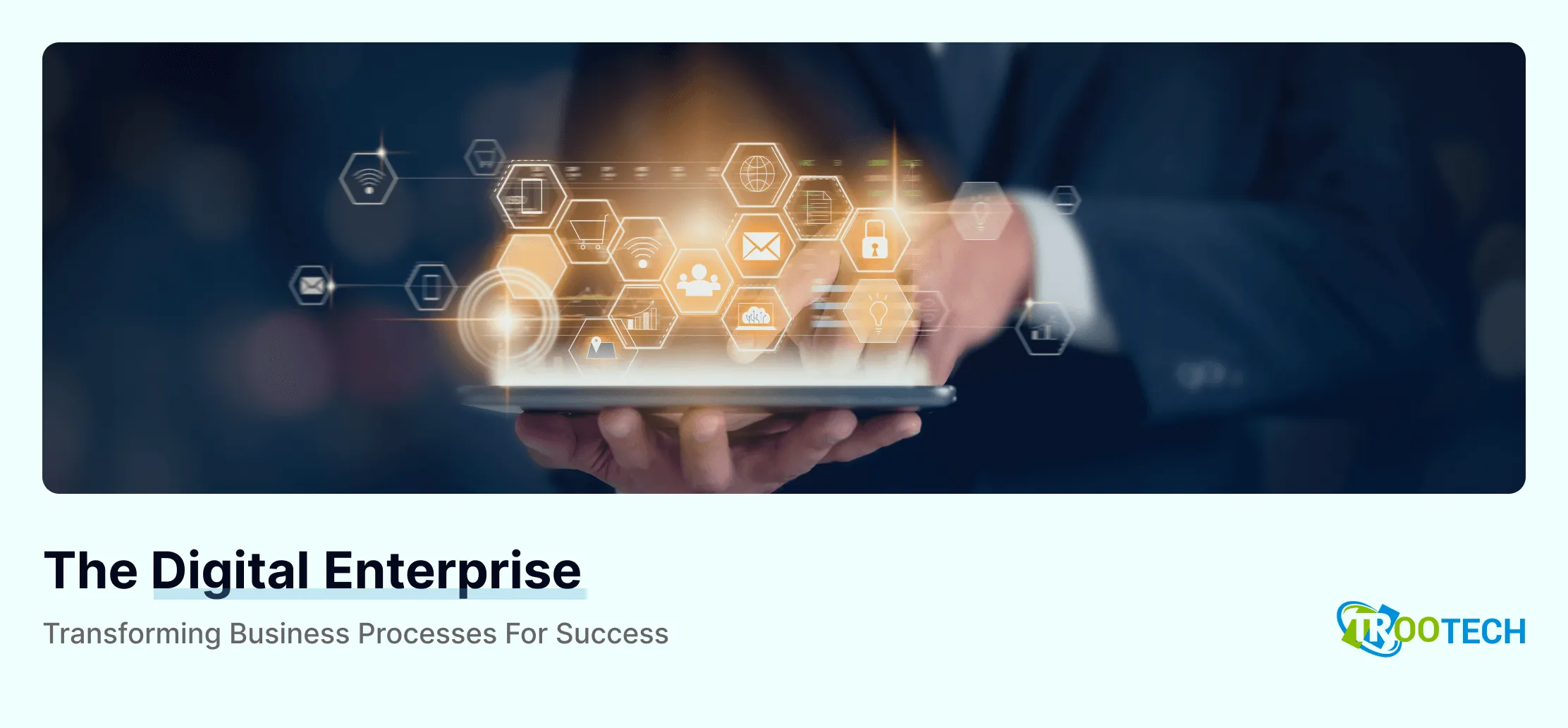Adopting Digital Technologies on Traditional Enterprise is The New Business Standard

Why Does Adopting Digital Technologies on Traditional Enterprise is the NEW NORMAL?
1. Digital Technologies Make Up For Labor Gaps in Traditional Enterprises
Industry 4.0 is important from the perspective of electronics manufacturing and there are a lot many reasons behind it. Such as quality enhancements, traceability, increasingly tiny electronic components, and labor shortages. The labor problem is made worse when aging populations are included in the equation. For instance, China is experiencing a manpower shortage. Despite having 1.4 billion people, its aging population forces labor-intensive sectors to use automation in order to continue operating. The Chinese government’s most recent five-year plan, covering the years 2021–2025, wants to increase automation in the manufacturing sector as a solution to this issue.
2. Digitalization Offers You Seamless Processes and Communication
The inherent efficiency for internal procedures and communication, where workflows tend to be paper-based is challenging across time frames. This is yet another operational benefit of digitization. Digitalization is essential to maintain the ongoing and efficient operation of the business in an era where paper-based communication and manual procedures can be severely hampered by sudden global disruptions. Due to the social alienation that occurred during this time, my organization swiftly adopted virtual communication tools, which have since become standard operating procedures in the present “new normal.”
3. Digital Marketing Supports Better Reach and Great Visibility
The use of digital marketing by businesses is one example of a digital response to the changes caused by the epidemic. In the past, a lot of global firms relied on cross-border travel and in-person meetings to coordinate projects with their clients, partners, and employees. These efforts have come to a complete end as a result of the epidemic. Major trade events that businesses once attended were postponed, canceled, or held virtually in 2021. This year, the CES trade show, one of the biggest in the electronics sector, was able to physically take place in Las Vegas. However, in contrast to pre-pandemic levels, it saw a 75% decrease in the number of visitors. Given the situation, it is not surprising that my business, along with many others, chose to focus on digital marketing.
Implementing Digital Technologies on Traditional Enterprises Comes With Roadblocks
Business executives must be aware that obstacles to digital transformation aren’t always rooted in technical issues or roadblocks. Organizational structures, human-centered challenges, and other non-tech aspects are also included. The easiest way to deal with them is to recognize and evaluate the specific issues that have an impact on your company. Here are a few of the major challenges that companies face when adopting digital technologies on traditional enterprise –
1. Short Supply of Resources
Unsuccessful resource planning and a shortage of IT resources are two of the major obstacles to digital transformation. Lack of labor force and talent war are two factors that stand in the way of a successful digital transformation in terms of IT resources. Without a skilled digital workforce, it will be impossible to successfully navigate the hurdles of digital transformation. Therefore, it is crucial to take this issue seriously and solve it before starting a digital transformation journey.
2. Heavy Reliance on Manual Processes
Oftentimes, organizations with manual processes and outdated systems have an archaic mentality. The pace of change is slow, automation is feared, and adopting new technologies is difficult. A significant obstacle to digital transformation is culture. Everyone, even senior management, and new personnel must concur. Everyone must be willing to make significant adjustments in their way of living and be unafraid to learn new abilities.
3. Lack of Proper Change Management
A detailed change management strategy is six times more prone to help an organization achieve its goals for digital transformation. (Prosci) A solid change management culture is essential for the success of any firm. Any new venture or action plan that doesn’t have a change strategy is doomed to failure. Establishing business relationships with all parties involved and employees while preparing a project by determining the underlying causes of problems are key components of an excellent change management strategy.
4. Heavy Potential of Security Risks
Privacy and cybersecurity considerations are a response that many enterprise firms in data-sensitive sectors have. That is true, too. The majority of digital transformation initiatives entail moving away from on-premise solutions and merging all of a company’s data into a single, centralized system. Naturally, this raises the potential of hackers that steal client information and business secrets. Cyberattacks can target weak points in systems, shoddy setups, and unwary users. Make sure you have a strategy in place to prevent these hazards from materializing. Hire a cybersecurity specialist to help you find gaps in your defense.
Apart from these, complex software and technology, organizational silos, constantly changing demands of customers, legacy systems, insufficient budget, adoption of new tools and processes, and digital skill gap are other such challenges that businesses face while taking on digitalization.
Setting up an effective system at work by adopting modern technologies can be a critical and lengthy process. TRooTech’s expert team simplifies every step that comes the way.
Sector-Wise Examples of Enterprise Digital Transformation
Business executives must be aware that obstacles to digital transformation aren’t always rooted in technical issues or roadblocks. Organizational structures, human-centered challenges, and other non-tech aspects are also included. The easiest way to deal with them is to recognize and evaluate the specific issues that have an impact on your company. Here are a few of the major challenges that companies face when adopting digital technologies on traditional enterprise –
1. Manufacturing Sector
Industry Scenario:
The manufacturing market’s digital transformation is anticipated to expand by USD 550 billion by 2031, with a CAGR of more than 17% predicted for the forecast period of 2021-31. COVID-19 has caused a change in traditional business models to new digitized ones, which has resulted in the development of more technologically sophisticated goods and services.
Digital Technology Solution:
- AI/ML driven technologies to utilize data potential: It is essential to employ algorithms to carry out swift operations because data is a company’s most valuable resource and can be quite important. Modern machines are able to foresee and identify the variables that will affect production, assembly-line speed, and quality, demonstrating that efficiency does not require sacrificing quality. The manufacturing industry is deploying AI-based solutions to increase productivity for two reasons: “data quantity” and “computer power.”
- IIoT to rebuild businesses’ internal processes: The manufacturing sector has been disrupted by IIoT, which has altered how goods are produced and supplied. Intelligent gadgets on factory floors can power artificial intelligence and predictive analytics. Real-time overview and monitoring, energy efficiency, increased productivity, and risk management have all been made possible by embracing IoT in internal operations, asset management, and human management.
- AR to transform business communication: The application of AR technology to expedite the assembly process for various product lines and enhance decision-making has enormous potential. There are numerous exchanges of emails and adjustments made before anything is put into production or manufacturing. This procedure is accelerated using AR, which can also enhance the task by streamlining teamwork and communication. The AR mechanism makes labor processes quicker and simpler.
- Industry 4.0 as the way to highly efficient factories: The elimination of antiquated and inefficient processes through the incorporation of linking machines and other intelligent devices is a disruptive trend that is forcing firms to build interconnected, intelligent networks that span the entire value chain from raw materials to finished goods.
2. Logistics Sector
Industry Scenario:
By 2026, it is predicted that the global spending on digital transformation in the logistics market would amount to US$94,972.3 million, growing at a 10.7% CAGR.
Digital Technology Solution:
- Smart Vehicles: We are rapidly approaching a time when autonomous cars will fully automate all aspects of transportation. The introduction of autonomous and self-driven trucks and vehicles into the supply chain for the transportation of goods would result in a significant reduction in prices.
- Cloud in Logistics: One of the most important trends is the introduction of cloud-based technology in the logistics industry. A supply chain might be difficult to manage by nature, necessitating the use of all your beneficial resources. Cloud-driven technology makes it feasible to manage online ticketing, organize logistical space, and track vehicles in real-time.
- IoT devices and Sensors: IoT-powered applications enable you to follow a product from the warehouse all the way to the client, giving the manager peace of mind that all supply chain steps are proceeding according to schedule. Applications for IoT logistics give real-time data at each level of the supply chain process, giving managers insightful information to spot inefficiencies and save resources.
3. Education Sector
Industry Scenario:
By 2028, the size of the global digital education market is projected to reach USD 77.23 billion, expanding at a compound annual growth rate (CAGR) of 30.5%.
Digital Technology Solution:
- AR/VR gives a holistic learning experience: Virtual and augmented reality is the next development in the educational system. Create a virtual tour using VR to explore the ideas at a completely new level. The use of exquisitely developed AR apps makes it possible to include a variety of features in a brand-new learning experience.
- Conversational AI helps curate learning content: AI-enabled chatbots can examine student responses and deliver instructional materials to them in accordance with their preferences. The bot can adapt the subsequent section in accordance with the student’s comprehension of the lecture, offering an entirely new experience.
- Learning apps and platforms: As more students enroll in online learning platforms and old industries are transformed by these platforms, the education sector has seen a significant transformation as a result of the growth of online learning. An interactive learning platform is built through the introduction of learning apps that allow students to access their notes, curriculum, and tests.
4. Healthcare Sector
Industry Scenario:
By 2026, the market for digital transformation in the healthcare industry is anticipated to be worth $20 billion, expanding at a CAGR of 10.4% between 2021 and 2026. Over the course of the projection period, it is anticipated that the market for digital transformation in healthcare will expand significantly. This growth will be primarily driven by improvements in healthcare infrastructure, government efforts, and healthcare system innovations.
Digital Technology Solution:
- Clinical apps: People frequently utilize web services and smartphone apps to monitor and manage their health issues while ill, as well as to improve their overall well-being. Clinicians are heavily reliant on mobile apps for their work on tablets and smartphones. These apps also range significantly in terms of the caliber of their data input interfaces, internal information processing, handling of confidential patient data, and output presentation.
- Personal health records and patient portals: A crucial component of person-centered treatment and collaborative decision-making is the use of personal health records (PHRs). Individuals can use digital technology to manage and maintain their health with the help of these technologies. To help with this, they might make it possible for consumers to record their own health and care information, interact with their medical team, and/or examine their medical records.
- Use of Artificial Intelligence for quality care: Similar to robots, AI technology can be utilized to improve productivity, cost-effectiveness, and healthcare quality. AI also makes it possible for patients to obtain individualized and effective care. Virtual nursing assistants provide similar roles to doctors by engaging with patients, gathering information about their symptoms, detecting ailments, and setting up appointments.
- Connected and Cognitive Devices: A recent study predicts that the market for wearable medical devices will surpass $27 million by 2023, a remarkable increase from almost $8 million in 2017. To achieve better health outcomes, connected and cognitive apparatus, such as wearable, portable, or ingestible devices, can be used. Patients can now manage their health from any location at any time thanks to this. The ability to manage health information encourages people to participate in their pursuit of improved health.
A Brief Overview of the Before & After of Digitization in Traditional Enterprises
The majority of traditional firms have been affected by digital disruption. This has led business leaders to change their operating models to suit the demands of a wider client base.
More than 80% of corporate executives in the modern world now give business digitization priority. Many of them believe that if they don’t digitize their firm, they risk losing their competitive advantage. And, this would have an impact on their bottom line. They are attempting to modernize and digitize their operations because of this.
Here we present to you a comparative analysis of the business scenario before and after the digitization of traditional enterprises. And, how it has posed a positive impact for traditional enterprises –
Comparative Analysis of the Business Scenario Before and After the Digitization of Traditional Enterprises
| The BEFORE Scenario | The AFTER Scenario |
|---|---|
| In the absence of digitization, it was difficult for traditional enterprises to attain a place in the market | Digitization makes it easy for traditional enterprises to achieve the competitive edge, hence attaining a substantial status in the market |
| Production and storage was difficult to keep a track of and manage as the processes completely had manual dependency | Digitization makes the tracking and management of production and storage simpler, given the automation of processes |
| Given the inefficiency of production, the deployment of products and solutions lagged a lot | Digitization made production faster and ensured enough stock to meet the demands, hence deployment is now fast and easy |
| Earlier the workplace looked like a physical reunion that led to more time-waste and ultimately in low productivity | The digital arena is the ultimate workspace in the AFTER scenario. This consists of highly-efficient software, monitoring systems, and trackers, which lead to better productivity |
| A hierarchical organizational structure is followed, consuming plenty of time in arriving at key decisions. This also delayed the processes and outcomes | Digitization calls for a flexible and collaborative structure, where timely decision-making is facilitated. Even the processes are expedited to eventually achieve better outcomes |
Points to Consider If Adopting Digital Technologies on Traditional Enterprise

The digital transformation process can get intimidating as there is so much uncertainty. However, it can get streamlined if you keep certain things in mind when considering digital transformation in your enterprise:
- Digital investment on such a vast scale is a challenging task. This is why ensuring the digital shift syncs with the company’s needs and growth is important.
- Changes do not happen overnight, and it takes time and meticulous planning. Thorough examination and understanding of the obstacles are crucial. This will help streamline the process of organizational restructuring.
- Communication is the key to successfully implementinging any new idea and reform, big or small. Ensure that whatever digital reform you have in mind is communicated clearly so that it is easy for everyone to adapt and there is no hindrance to the organization’s functioning.
- Proper planning is a must to make sure that the changes implemented are future-oriented and not just about present needs. Migrating the systems is not only time-consuming but also costly. It is important to consider all the variables before investing so that it brings growth and stability in the organization. Determining the estimated costs, potential benefits, and returns is essential before integrating digital changes.
- Training the current workforce can help streamline the transformation process. This will make the employees competent to adapt to the new methods, and a lack of skills won’t hinder the digital shift.
- Outsourcing is another solution that can be adopted to enhance the company’s infrastructure. Hiring a team of experts for your IT solutions is faster and more efficient. It will allow you to select the perfect team that matches your requirements at your budget worldwide.
- Security is a significant issue that comes up when digitally transforming the infrastructure. The key to doing that is to first ensure that any change in the system happens securely. And secondly, cybersecurity services are upgraded regularly. Data protection is the most important thing for an organization, so it is important to have a robust security system.
Digital transformation is necessary for a successful business and a smooth work environment. However, having the right strategy for these changes is essential for generating fruitful results. That’s where TRooTech can help you. We will customize digital solutions for all your business needs so that you can upgrade your infrastructure hassle-free.
A successful and smooth workflow system at the workplace requires the best implementation of digital technologies. If it’s done through the right process, the efficiency can be doubled. That’s where TRooTech can help your business!

